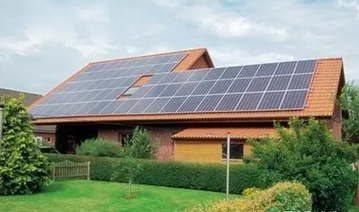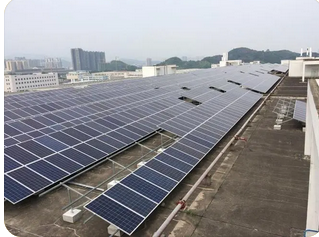What are the overall advantages of distributed photovoltaic power generation?
Advantages of distributed PV:
(1) The power is relatively small. Generally speaking, the volume of a distributed PV power generation project is within several KW. Unlike centralized power stations, the size of photovoltaic power stations has little impact on the quality of power generation, and therefore has little impact on rationality. The return on investment of small and medium-sized photovoltaic power generation systems cannot be lower than that of large ones.
(2) Small environmental pollution and environmental benefits highlight that distributed photovoltaic power generation projects have no noise and will not cause environmental pollution to air and water during the power generation process.
(3) It can alleviate the tension of electricity consumption in some areas to some extent. However, the specific energy of distributed photovoltaic power generation is low, and the overall output power of distributed photovoltaic power generation is only about 100 watts per square meter. In addition, the total roof area of buildings suitable for assembling solar modules is relatively limited, which can not effectively solve the problem of power consumption anxiety.
(4) The large and medium-sized road power stations that can generate electricity and use electricity are connected to the transmission network by voltage transformation, and only operate as power stations; However, distributed photovoltaic power generation is connected to the distribution network, where power generation and consumption coexist, and it is required to conduct centralized treatment as close as possible.

What are the benefits of distributed photovoltaic power generation and electric heating?
Advantages of distributed PV:
(1) Low power
Generally speaking, the volume of a distributed photovoltaic power generation project is within a few KW. Unlike centralized power stations, the size of photovoltaic power stations has little impact on the quality of power generation, and therefore has little impact on rationality. The return on investment of small and medium-sized photovoltaic power generation systems cannot be lower than that of large ones.
(2) Small environmental pollution and outstanding environmental benefits
In the power generation process of distributed photovoltaic power generation project, there is no noise and will not cause environmental pollution to air and water.
(3) It can reduce the power tension in local areas to a certain extent
However, the specific energy of distributed photovoltaic power generation is relatively low, the overall output power of distributed photovoltaic power generation is only about 100 watts per square meter, and the total roof area of buildings suitable for assembling solar modules is relatively limited, which can not effectively solve the problem of power consumption anxiety.
(4) Able to generate and use electricity
The power generation of large and medium-sized road power stations is connected to the transmission network through voltage transformation, and only operates as power generation stations; However, distributed photovoltaic power generation is connected to the distribution network, where power generation and consumption coexist, and it is required to conduct centralized treatment as close as possible.

Advantages of distributed PV grid connection?
Distributed photovoltaic power station refers to the power generation system software with relatively small installed scale and distributed near the customer. It is generally connected to the power grid with 10KV or lower rated voltage. The small-scale rooftop photovoltaic power stations we usually see are distributed photovoltaic power stations.
Distributed photovoltaic power station is a new method of power generation and power energy development and utilization with broad development prospects. It advocates the basic principle of power generation based on the principle of proximity, grid connection based on the principle of proximity, transformation based on the principle of proximity, and application of the principle of proximity. It can not only effectively improve the power generation of photovoltaic power stations with the same operating model, but also fundamentally solve the consumption problem of power engineering in the transformation and long-distance freight.
Advantages of distributed photovoltaic power station
1. Relativity of power is small, and the operation scale can be flexibly adjusted
The volume of distributed photovoltaic power generation project is between several KW and several megawatts, and the power is far less than that of large and medium-sized pavement photovoltaic power stations; The scale of operation can be adjusted through the modularization of photovoltaic power generation; The volume of photovoltaic power generation system can be adjusted according to the total roof area and construction conditions and other factors; The installation method is relatively flexible and suitable for decentralized capital construction in the areas where energy consumption is concentrated.
2. The new project has less environmental pollution and outstanding environmental benefits
Like other new energy projects, distributed photovoltaic power generation has no pollution and noise in the process of power generation, and will not cause environmental pollution to air and water. It is suitable for the development trend of livable cities and remote areas, and is one of the efficient ways to prevent haze and establish the overall goal of energy conservation and consumption reduction.
3. Co-existence of power generation and consumption, low line loss of power lines
Large-scale and medium-sized road photovoltaic power generation is connected to the transmission network through voltage transformation, which is only used as the power generation switching power supply to participate in the grid operation, while distributed photovoltaic power generation is connected to the distribution network, which is directly used for power generation, and the vast majority can be processed in a centralized way nearby. Because there is no long-distance transportation, there is no line loss, and it is directly processed from the distribution network in a centralized way. The utilization rate is widely higher than that of the photovoltaic power station on the road.
4. Close to the load center, no impact on the power grid
Distributed photovoltaic power stations are generally distributed in the load center areas of China and the eastern region, and are sold to large and medium-sized industrial customers, housing, etc. immediately. There is no need for long-distance transportation, which saves the cost of power grid. The operating scale is generally smaller than that of grid-connected photovoltaic power stations on the road, and the harm to the frequency and voltage fluctuation of the power grid is relatively limited.
5. Save soil resources and project costs
The new project of distributed photovoltaic power station does not need to be developed and designed on the centralized and contiguous land, so it can effectively save soil resources and improve the utilization rate of leisure roof and workshop. At the same time, in the context of the increasing demand for electricity by large commercial entities, the owners of the community have the enthusiasm to basically build distributed photovoltaic power stations. The cost of new projects is generally lower than that of large and medium-sized grid-connected photovoltaic power stations.

Disadvantages of distributed photovoltaic power station
1. There are many participants and uncontrollable factors increase
Distributed photovoltaic power stations involve more rooftop users and energy-consuming companies. Due to the permeability and diversity in the project implementation process, the business operation models derived from them are also different. The uncontrollable factors are widely more than those of new projects of pavement photovoltaic power stations. For example, some new projects may have uncontrollable factors such as roof ownership transfer, force majeure, contract risk, etc, Therefore, the development, design and operation of distributed photovoltaic power stations are more complex than large and medium-sized grid-connected photovoltaic power stations.
2. The efficiency of electricity bill settlement is relatively low
At this stage, the settlement of electricity charges for distributed photovoltaic power stations is mostly based on the energy management method of contract, which lacks the guarantee of payment collection and contract performance, and is affected by the operation of power enterprises. The timeliness and reliability of the recovery and utilization of water and electricity charges deserve attention.






